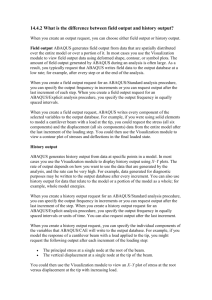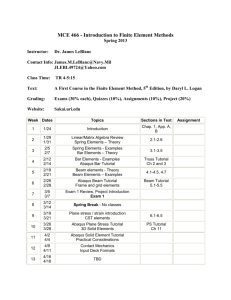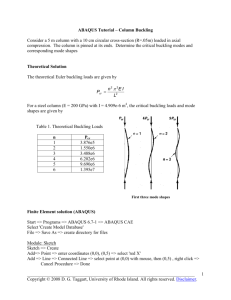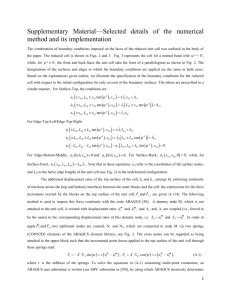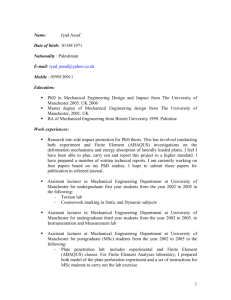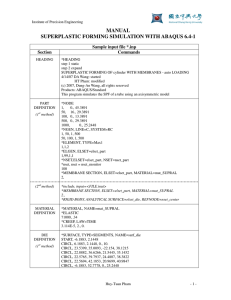AE3122 ABAQUS Lecture Part I
advertisement
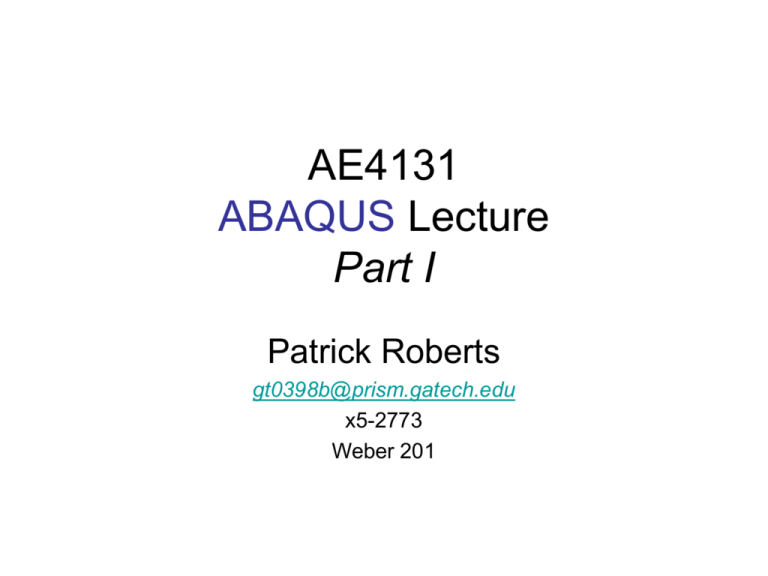
AE4131 ABAQUS Lecture Part I Patrick Roberts gt0398b@prism.gatech.edu x5-2773 Weber 201 Overview • What is ABAQUS? • Why learn ABAQUS? • ABAQUS documentation and online resources • Solver structure • How to build a simple model What is ABAQUS? The ABAQUS suite of software for finite element analysis (FEA) is known for its high performance, quality and ability to solve more kinds of challenging simulations than any other software. The ABAQUS suite consists of three core products: ABAQUS/Standard, ABAQUS/Explicit and ABAQUS/CAE. Each of these packages offers additional optional modules that address specialized capabilities some customers may need. (From www.abaqus.com) What is ABAQUS? • ABAQUS/Standard®, provides ABAQUS analysis technology to solve traditional implicit finite element analyses, such as static, dynamics, thermal, all powered with the widest range of contact and nonlinear material options. ABAQUS/Standard also has optional add-on and interface products with address design sensitivity analysis, offshore engineering, and integration with third party software, e.g., plastic injection molding analysis. • ABAQUS/Explicit®, provides ABAQUS analysis technology focused on transient dynamics and quasi-static analyses using an explicit approach appropriate in many applications such as drop test, crushing and many manufacturing processes. • ABAQUS/CAE®, provides a complete modeling and visualization environment for ABAQUS analysis products. With direct access to CAD models, advanced meshing and visualization, and with an exclusive view towards ABAQUS analysis products, ABAQUS/CAE is the modeling environment of choice for many ABAQUS users. (From www.abaqus.com) Why learn ABAQUS? • Experience has shown that ABAQUS is the easiest FEA software package to learn. • Very good online documentation • Small learning curve which means you can model much faster. ABAQUS documentation and online resources • There are many online resources to help you find solutions. • ABAQUS Documentation http://www.isye.gatech.edu/v6.4 • Newsgroup sci.engr.analysis • ABAQUS Yahoo group • Engineering Computing Services http://www.ecs.gatech.edu Solver Structure Command line ABAQUS CAE Standard How to build a simple model • All models are called input files. • An input file has two sections; Model and History • The Model section contains all the information about the model and comes before the history section. • The History section is what you do to the model. You work on the model in Steps. • Input files have a .inp extension and can be created in any ASCII (text) editor. Beam example y, 2 20,000 lbs x, 1 Steel beam, Young’s modulus 30x106 lbs/in2 Length 100 inches, width = 1 inch, height = 2 inches Beam example I want to know stresses and strains along the x-direction and the forces and moments in each section of the beam due to a static load. Sketch out your FEA model y, 2 20,000 lbs 2 1 1 4 3 2 Nodes Elements 3 5 4 5 6 x, 1 Pick your elements • ABAQUS has a large library of elements (From ABAQUS documentation) • I’ll pick B31 2-node linear beam Simple Input file (Model data) *HEADING CANTILEVER BEAM ** ** This is in inches ** *NODE 1, 0. 6, 100. *NGEN, NSET=allnodes 1, 6 *ELEMENT, TYPE=B31 1, 1, 2 *ELGEN, ELSET=BEAM 1, 5 *BEAM SECTION, SECTION=RECTANGULAR, ELSET=BEAM, MATERIAL=STEEL 1., 2. *MATERIAL, NAME=STEEL *ELASTIC 30.E6, *BOUNDARY 1, ENCASTRE Simple Input file (History Section) *STEP, PERTURBATION *STATIC ** ** The load is in pounds ** *CLOAD 6, 2, -20000. *EL PRINT, POSITION=AVERAGED AT NODES, SUMMARY=YES S11, E11 SF, *NODE FILE, NSET=allnodes U, CF, RF *OUTPUT, FIELD, VARIABLE=PRESELECT *ELEMENT OUTPUT SF, *OUTPUT, HISTORY *NODE OUTPUT, NSET=allnodes U, CF, RF *END STEP To run ABAQUS • At the command line abaqus job=filename Use the Input File filename WITHOUT the file extension (.inp) The results You will get many files after your job is complete. .dat Contains results information you can read. Very important for debugging. .fil Only for the computer .com Only for the computer .odb Only for the computer but will be used by CAE .msg Contains information you can read about how the job ran. Can be important for debugging. .prt Only for the computer .sta Contains information you can read about the status of the job while running .log Contains information you can read about how the job ran. Can be important for debugging. A truss problem y, 2 20 in. 100 lbs x, 1 20 in. Steel truss segments, Young’s modulus 30x106 lbs/in2 Diameter of each truss is 1 inch 200 lbs Beam example I want to know stresses and strains in all truss segments due to the static loads shown in the figure. Sketch out your FEA model y, 2 7 8 6 7 12 11 17 1 1 9 8 13 2 9 3 3 11 12 16 20 4 4 x, 1 5 Steel truss segments, Young’s modulus 30x106 lbs/in2 Diameter of each truss is 1 inch 10 15 14 19 18 2 10 5 6 Pick your elements (From ABAQUS documentation) • I’ll pick T3D2 2-node linear displacement Modal Section *HEADING CANTILEVER BEAM ** ** This is in inches ** *NODE 1, 0., 0. 6, 100., 0. 7, 0., 20. 12, 100., 20. *NSET, NSET=FIXED 1, 7 *NGEN, NSET=allnodes 1, 6 7, 12 *ELEMENT, TYPE=T3D2, ELSET=BEAM 1, 1, 2 2, 2, 3 3, 3, 4 4, 4, 5 5, 5, 6 6, 7, 8 7, 8, 9 8, 9, 10 9, 10, 11 10, 11, 12 11, 1, 8 12, 2, 9 13, 3, 10 14, 4, 11 15, 5, 12 16, 6, 12 17, 2, 8 18, 3, 9 19, 4, 10 20, 5, 11 *SOLID SECTION, ELSET=BEAM, MATERIAL=STEEL 1., *MATERIAL, NAME=STEEL *ELASTIC 30.E6, *BOUNDARY FIXED, ENCASTRE History Section *STEP, PERTURBATION *STATIC ** ** The load is in pounds ** *CLOAD 6, 1, 200. 12, 2, -100, *EL PRINT, POSITION=AVERAGED AT NODES, SUMMARY=YES S, E *NODE FILE, NSET=allnodes U, CF, RF *OUTPUT, FIELD, VARIABLE=PRESELECT *ELEMENT OUTPUT S, E *OUTPUT, HISTORY *NODE OUTPUT, NSET=allnodes U, CF, RF *END STEP Looking at the results files Starting with the .log file you should review the results files. Models with continuum elements • To model most 3D structures that are bending Continuum or brick elements are the best. • Each element requires any nodes. • Models can be made by hand rather than CAE but can take much longer. Continuum Elements 3D Cantilever Beam Model data *HEADING cantilever beam ** ** Coordinates are in inches ** *NODE 1, 0.,0.,0. 193, 0.,0.,24. 1601, 2.,0.,0. 1793, 2.,0.,24. 8001, 0.,0.5,0. 8193, 0.,0.5,24. 9601, 2.,0.5,0. 9793, 2.,0.5,24. ** ** Create nodes for beam ** *NGEN,NSET=FIX1 1,1601,200 *NGEN,NSET=FIX2 8001,9601,200 *NFILL,NSET=FIX FIX1,FIX2,4,2000 *NGEN,NSET=END1 193,1793,200 *NGEN,NSET=END2 8193,9793,200 *NFILL,NSET=END END1,END2,4,2000 *NFILL,NSET=CBEAM FIX,END,192,1 ** *NSET, NSET=SENSOR 8993 Model section (cont.) ** ** Make master elements for beam ** *ELEMENT,TYPE=C3D20R 1, 1,401,4401,4001, 5,405,4405,4005, 201,2401,4201,2001, 205,2405,4205,2005, 3,403,4403,4003 ** ** Create elements for beam ** *ELGEN,ELSET=CBEAM 1,4,400,1,48,4,10,2,4000,2000 *ELSET, ELSET=LOCSTRESS 2,3,12,22,32,42,52,62,13,23,33,43,53,63,2002,2003 2012,2022,2032,2042,2052,2062,2013,2023,2033,2043,2053,2063 ** ** Material properties for steel ** *SOLID SECTION, MATERIAL=STEEL, ELSET=CBEAM *MATERIAL, NAME=STEEL ** ** Youngs modulus is in lbf/in^2 ** *ELASTIC 29.E6,0.3 ** Student Accounts • Now you are ready to work the projects. • You can use your AE student account in the AE Computer Lab (Knight 318) to run ABAQUS on these systems. • Or you can get an account on the ECS network (go to http://www.ecs.gatech.edu)
